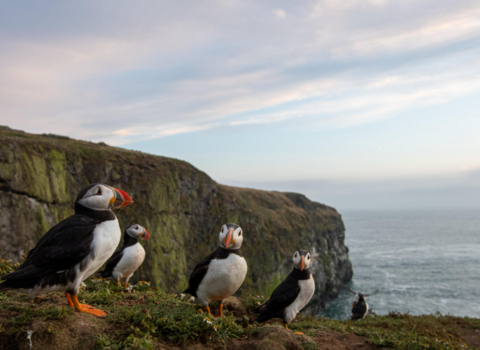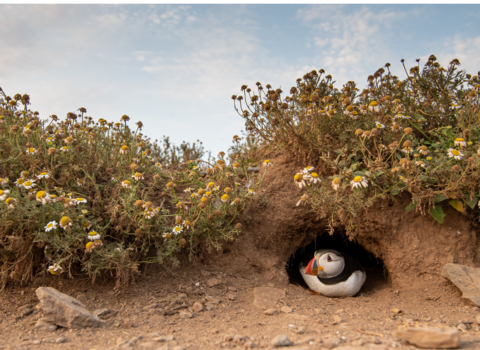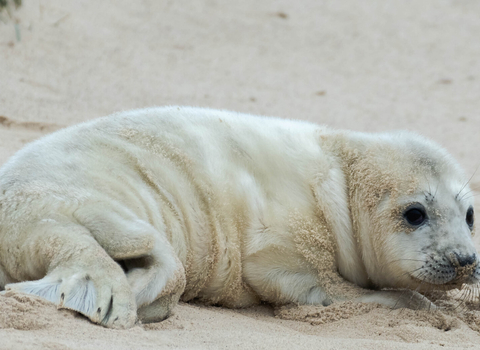Find out all about the wildlife of Skomer Island - one of the most important seabird sites in southern Britain with maritime grassland, lush inland vegetation, bubbling streams and man-made ponds supporting a host of wildlife including Atlantic Puffins, Manx Shearwaters, Guillemots, Razorbills, Skomer Voles and much more.
Please note that Puffins are only on island from mid April to late July.
Wildlife
For up to date wildlife sightings, please see our island blog:
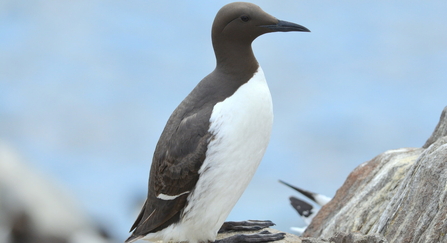
Guillemot - Adam Jones
Birds
Skomer is internationally important for seabirds.
- There are nearly 350,000 pairs of breeding Manx Shearwaters which is the largest colony in the world
- 41,605 Puffins were recorded in 2024 (please note that Puffins are only on island from mid April to late July).
- Storm Petrels, Guillemots and Razorbill colonies present a significant proportion of the total British population of these species
- Thousands of Kittiwakes and hundreds of Fulmars are joined by Herring, Lesser and Great Black-backed Gulls on the cliffs
Other breeding species in 2024 included Short-eared Owl, Curlew, Chough, Peregrine, Oystercatcher, Raven, Buzzard, Kestrel, Meadow Pipit, Wheatear, Rock Pipit, Whitethroat and Dunnock.
Plant Life
During May and June the island is carpeted with Bluebells and Red Campion, with Thrift and Sea Campion seen along cliff edges later in the year. Large areas of the island are dominated by Bracken and salt and wind-tolerant maritime grasses.
Mammals
Land mammals include an endemic vole species, the Skomer Vole, as well as Wood Mouse, Rabbit, Common and Pygmy Shrew.
The island has no rats which is important for ground-nesting birds.
There have been 7 species of bat recorded on Skomer in recent years including Common Pipistrelles and the much rarer Greater Horseshoes.
Grey Seals haul out on the rocks at low tide and breed on the beaches in autumn – we record approximately 250 pups each year.
Common Dolphin, Risso's Dolphin, Bottlenose Dolphin and Harbour Porpoise are frequent visitors to our waters.
Other Wildlife
The reptiles and amphibians on the island are Slow Worm, Common Lizard, Common Toad, Common Frog and Palmate Newt.
Butterflies include Meadow Brown, Small Copper, Dark Green Fritillary, Peacock and Painted Lady. We also record many moth species on the island.
Environmental designation
Marine Conservation Zones (MCZ)
Marine Protected Areas (MPA)
National Nature Reserve (NNR)
Scheduled Ancient Monument
Site of Special Scientific Interest (SSSI)
Special Protection Areas (SPA)
Skomer Island - A Brief History
This summary gives you an idea of Skomer's unique history - from the Ice Age to the modern day.
Although there have been a number of academic studies of island history, there has never been a major archaeological dig and therefore much of what we know is from field observation and comparisons to other sites. When the vegetation is low, the historic features of the island can be seen more clearly.
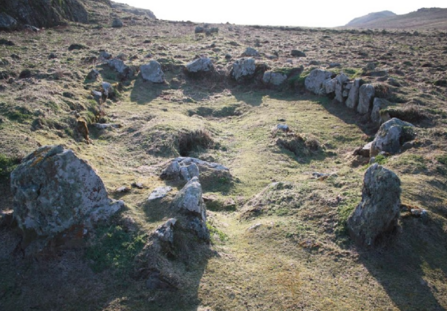
Iron Age Roundhouse by the Wick - © WTSWW
Skomer's Name
Skomer derives from its Viking name Skalmey, as seen on old maps and texts. This name is of Viking origin, coming from two words “skalm” meaning a short sword or cleft, and “ey” meaning island thus “Cleft Island”. This probably refers to the fact that the island appears almost cut in two, joined only by a narrow strip of land known as The Isthmus. Many islands around the Welsh coast have names that are Viking in origin though there is no hard evidence of Viking occupation on Skomer.
Early History
We know that there were nomadic hunter-gatherer communities in south west Wales around 37,000 years ago. At that time, Skomer would have been part of the mainland. It only became cut off at the end of the last Ice Age around 12,000 years ago, following sea level rise. There is no clear evidence, bar a few flint flakes, that the area now known as Skomer was used by these hunter-gatherers.
Iron Age
The main Iron Age settlement on Skomer can be dated between 5000 and 2000 years ago. The remains of huts, fields and cairns on Skomer are some of the most complete and untouched remains of this period in the whole of Europe. Their presence indicates an Iron Age farming community of up to 200 people. The importance of the site has been recognised with most of the island designated as a Scheduled Ancient Monument.
Middle Ages
Following the Iron Age, there is no clear history of habitation until the Middle Ages, when in the 13th century rabbits were introduced to the Island. Rabbits were brought to the British Isles by the Normans and were a valuable source of food and fur. and were a major export from the island to local markets. There is some evidence of Medieval buildings on the site.
18th Century to Modern Day
The old farmhouse ruin, seen today in the centre of the island dates from about 1840 but a similarly substantial house is first thought to have been built on the site around 1700. The slightly thicker soils in this part of the island and access to water in North Valley enabled a range of crops to be grown. There are records of the farm supporting three families at one stage with cows and sheep grazing the as well as horses to help with the heavy work. Farming was largely abandoned after the outbreak of the First World War and all agriculture on the island finally ended in 1950. In 1959 the Island was bought by the Nature Conservancy (the Government department that became the Countryside Council for Wales) helped by the West Wales Field Society (the charity that became the Wildlife Trust of South and West Wales). It was declared one of the country’s first National Nature Reserves and is now owned by NWR and managed by the Wildlife Trust of South and West Wales.

